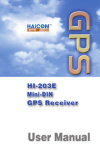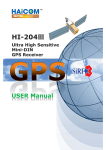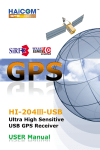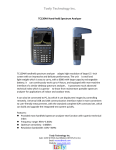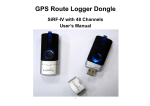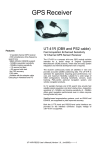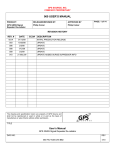Download User Manual - Pdfstream.manualsonline.com
Transcript
HI-204E Mini-DIN GPS Receiver User Manual HI-204E WATERPROOF GPS Receiver 1 General description of what GPS is and how it works. GPS (Global Positioning System) is the only system today able to show you your exact position on the Earth anytime, in any weather, anywhere. GPS satellites, 24 in all, orbit at 11,000 nautical continuously miles monitored above by the ground Earth. They stations are located worldwide. The satellites transmit signals that can be detected by anyone with a GPS receiver. Using the receiver, you can determine your location with great precision. The satellites are positioned so that we can receive signals from six of them nearly 100 percent of the time at any point on Earth. You need that many signals to get the best position information. Satellites are equipped with very precise clocks that keep accurate time to within three nanoseconds- that's 0.000000003, or three billionths of a second. This precision timing is important because the receiver must determine exactly how long it take s for signals to travel from each GPS satellite. The receiver uses this information to calculate its position. 2 Although GPS was designed for military use, many thousands of civi lians make use of it. The satellites actually broadcast two signals, one is only formilitary use, and the ther can be used by both military and civilians. Since GPS is passive (you only need to receive the signal), there are no restrictions on who can use the signal available to civilians. GPS technology can be used in a variety of fields besides providing navigation for vehicles on the sea, in the air and on the ground. GPS applications also include keeping track of where a fleet of trucks, trains, ships or planes are and how fast they are moving; directin gemergency vehicles to the scene of an accident; mapping where a city's assets are located ; and providing precise timing for endeavors that require large-scale coordination. 3 GLOBAL POSITIONING SYSTEM HI-204E GPS RECEIVER Pin Assignment Connectors 1 3 5 2 4 6 1800±30mm 1 2 PS/2 Connector Color Function CN1 Green TX 5 White 4 RX 4 Red VCC 2 Black GND 1 1 Mini Din: 6 pin male connector 2 Wire: 3.6 ± 0.1mm Pocket PC HI-204E PS/II GPS receiver Can Connecting to a female PS/II Connector. One end from the female Connector is +12V car charger (charging PDA and GPS receiver simultaneously) the other end form the female PS/II connector is the PDA connector for connecting your PDA. For notebook PC use: HI-204E PS/II can also connect with a PS/II to DB9 PS-232 serial cable or USB connector. 5 1. HI-204E Series Introductions HI-204E is a GPS receiver with PS/II mini-DIN interfaces and built-in active antenna for high sensitivity to tracking signal. HI-204E is well suited to system integration and users who use any kinds of mobile devices, such as, PDA, notebook PC, Tablet PC, etc. It satisfies a wide variety of applications for car navigation, personal navigation or touring devices, tracking and marine navigation purpose. Users can simply plug it into a PDA or other type of handheld PC running with suitable mapping and routing software for navigation. 1.1 Standard Package Before you start up, make sure that your package includes the following items. If any items are missing or damaged, contact your dealer immediately. • HI-204E GPS Receiver unit • Suction CUP • User Manual CD (including User Manual, HaiTest Testing Program, Driver for PCMCIA card slot of Notebook PC) 6 Optional Accessories: • PS/II to PDA connector and car charger • PS/II to DB9 adapting cable • PS/II to USB adapting cable HI-204E-USB HI-204E-XXXX (Pocket PC Plug) HI-204E-DB9 7 SECTION 1 INTRODUCTION 1.1 OVERVIEW Fast Acquisition Enhanced Sensitivity 12 Channel GPS Sensor Module The HI-204E is a compact all-in-one GPS module solution intended for a broad range of Original Equipment Manufacturer (OEM) products, where fast and easy system integration and minimal development risk is required. The receiver continuously tracks all satellites in view and provides accurate satellite positioning data. The HI-204E is optimized for applications requiring good performance, low cost, and maximum flexibility; suitable for a wide range of OEM configurations including handhelds, sensors, asset tracking, PDA-centric personal navigation system, and vehicle navigation products. Its 12 parallel channels and 4000 search bins provide fast satellite signal acquisition and short startup time. Acquisition sensitivity of -137dBm and tracking sensitivity of -145dBm offers good navigation performance even in urban canyons having limited sky view. 8 Satellite-based augmentation systems, such as WAAS and EGNOS, are supported to yield improved accuracy. Both the LVTTL-level and RS232-level serial interface are provided on the interface connector. Supply voltage of 3.3V, or 3.8V~12V are supported. 1.2 Features • 12 parallel channel GPS receiver • 4000 simultaneous time-frequency search bins • SBAS (WAAS, EGNOS) support • -137dBm acquisition sensitivity • -145dBm tracking sensitivity • < 10 second hot start • < 45 second cold start • 5m CEP accuracy 9 SECTION 2 RECEIVER OPERATION Upon power up, after initial self-test has completed, the HI-204E will begin satellite acquisition and tracking process. Under normal open-sky condition, position-fix can be achieved within approximately 35 seconds (within 10 seconds if valid ephemeris data is already collected from recent use). After receiver position has been calculated, valid position, velocity and time information are transmitted through the on board serial interface. The receiver uses the latest stored position, satellite data, and current RTC time to achieve rapid GPS signal acquisition and fast TTFF. If the receiver is transported over a large distance across the globe, cold-start automaticlocate sequence is invoked. The first position fix may take up to 50 sec searching the sky for the GPS signal. The acquisition performance can be improved significantly if the host initializes the receiver with a rough estimate of time and user position. 10 As soon as GPS signal is acquired and tracked, the HI-204E will transmit valid navigation infor mation through its ser ial interface. The navigation data contains following information: • Receiver position in latitude, longitude, and altitude • Receiver velocity • Time • DOP error-magnification factor • GPS signal tracking status The HI-204E will perform 3D navigation when four or more satellites are tracked. When three or fewer satellites are tracked, altitude-hold is enabled using the last computed altitude and 2D navigation mode is entered. With signal blockage or rising and setting of the satellites, where a change in satellite constellation used for position fix occurred, large position error may result. The HI-204E incorporates a proprietary algorithm to compensate the effect of satellite constellation change, and maintains an accurate smooth estimate of the receiver position, velocity, and heading. 11 2.1 TECHNICAL SPECIFICATIONS FEATURES Receiver Type Accuracy DESCRIPTIONS 12 parallel channel, L1 C/A code Position: 5m CEP Velocity: 0.1m/sec Startup Time < 10sec hot start < 45sec cold start Reacquisition Sensitivity Update Rate 1s -137dBm acquisition -145dBm tracking 1Hz Dynamics Operational Limits 4G (39.2m/sec2) Altitude < 18,000m or velocity < 515m/s (COCOM limit, either may be exceeded but not both) Serial Interface Protocol Input Voltage LVTTL level and RS-232 level NMEA-0183 V3.01 GPGGA, GPGLL, GPGSA, GPGSV, GPRMC, GPVTG, GPZDA 4800 baud, 8, N, 1 Default WGS-84 User definable Two 1.0mm pitch WTB S/R wafer 87213 SMT R/A type connector 3.3V DC +/-100mV 3.8V ~ 12.0V Current Consumption Dimension Weight Operating Temperature 90 ~ 110mA 43mm L x 42mm W x 13mm H 23g -40°C ~ +85°C Datum Interface Connector 2.2 LED INDICATOR LED flashing 0.25Hz LED flashing 1Hz 12 Signal Searching Position Fixed < 35sec warm start SECTION 3 HARDWARE INTERFACE 3.1 MECHANICAL DIMENSIONS Unit:mm Top View 69±0.2 I/O Cable Build-in patch antenna Lateral View 20±0.2 I/O Cable Bottom View LED indicator 69±0.2 I/O Cable CPU Magnetic 73±0.2 13 Patch Antenna pin-1 HI-204E Lateral View 3.2 PINOUT DESCRIPTION Pin Number Signal Name Description Asynchronous serial 1 Serial Data Out 1 output at LVTTL level, to output NMEA message Asynchronous serial input 2 Serial Data In 1 at LVTTL level, to input command message Asynchronous serial 3 Serial Data Out 2 output at RS-232 level, to output NMEA message Asynchronous serial input 4 Serial Data In 2 at RS-232 level, to input 5 Power 3.8V ~ 12.0V DC input 6 Ground Power and signal ground command message 14 3.3 ONE-PULSE-PER-SECOND (1PPS) OUTPUT The one-pulse-per-second output is provided for applications requiring precise timing measurements. The output pulse is 1usec in duration. Rising edge of the output pulse is accurate to +/-1usec with respect to the start of each GPS second. Accuracy of the one-pulse-per-second output is maintained only when the GPS receiver has valid position fix. The 1PPS output is always generated when the GPS receiver is powered-on. Proper adjustment of the 1PPS output to align with the GPS second requires calculation of the receiver clock offset and clock drift-rate as part of the position-velocity-time (PVT) solution. When enough satellite signals are received to generate valid position fixes, the 1PPS output is adjusted to align with the GPS second in several seconds. When the 1PPS output is brought in sync with the GPS second, the 1PPS Valid Signal on the I/O pin becomes active (HIGH); when the 1PPS output is not yet in sync with the GPS second, the 1PPS Valid Signal remains inactive (LOW). 15 As long as enough satellite signals are received to generate valid position fixes, the 1PPS output remains synchronized to the GPS second, and the 1PPS Valid Signal remains active. If signal blockage prevents the receiver from generating valid position fix, the 1PPS output will drift away from the GPS second and the 1PPS Valid Signal will become inactive. Upon re-acquiring enough satellites to generate consecutive valid position fixes, the 1PPS Valid Signal will become active again, signaling that the 1PPS output is again synchronized with the GPS second. For best stable operation of the 1PPS signal, it is to be operated in static environment having clear view of the sky. 16 SECTION 4 SOFTWARE INTERFACE This section describes the details of the serial port commands through which the HI-204E is controlled and monitored. The serial port commands allow users to set the receiver parameters, configure output message type, and retrieve status information. The baud rate and protocol of the host COM port must match the baud rate and protocol of the GPS receiver serial port for commands and data to be successfully transmitted and received. The default receiver protocol is 4800baud, 8 data bits, 1 stop bit, and none parity. 4.1 NMEA OUTPUT MESSAGE SPECIFICATION The HI-204E supports NMEA-0183 output format as defined by the National Marine Electronics Association (http://www.nmea.org). The currently supported NMEA messages for GPS applications are: GGA Global Positioning System Fix Data GLL Geographic Position Latitude / Longitude GSA GNSS DOP and Active Satellites GSV GNSS Satellites in View RMC Recommended Minimum Specific GNSS Data VTG Course Over Ground and Ground Speed 17 4.1.1 NMEA Messages The serial interface protocol is based on the National Marine Electronics Association's NMEA 0183 ASCII interface specification. This standard is fully define in "NMEA 0183, Version 3.01" The standard may be obtained from NMEA, www.nmea.org 4.1.2 GGA - GPS FIX DATA Time, position and position-fix related data (number of satellites in use, HDOP, etc.). Format: $GPGGA,<1>,<2>,<3>,<4>,<5>,<6>,<7>,<8>,<9>, M,<10>,M,<11>,<12>,*<13><CR><LF> Example: $GPGGA,104549.04,2447.2038,N,12100.4990,E,1,06, 01.7,00078.8,M,0016.3,M,,*5C<CR><LF> 18 Field Example Description 1 104549.04 UTC time in hhmmss.ss format, 000000.00 ~ 235959.99 2 2447.2038 Latitude in ddmm.mmmm format Leading zeros transmitted 3 N Latitude hemisphere indicator, 'N' = North, 'S' = South 4 12100.4990 Longitude in dddmm.mmmm format Leading zeros transmitted 5 E Longitude hemisphere indicator, 'E' = East, 'W' = West 6 1 Position fix quality indicator 0: position fix unavailable 1: valid position fix, SPS mode 2: valid position fix, differential GPS mode 7 06 Number of satellites in use, 00 ~ 12 8 01.7 Horizontal dilution of precision, 00.0 ~ 99.9 9 00078.8 Antenna height above/below mean sea level, -9999.9 ~ 17999.9 10 0016.3 Geoidal height, -999.9 ~ 9999.9 11 Age of DGPS data since last valid RTCM transmission in xxx format (seconds) NULL when DGPS not used 12 Differential reference station ID, 0000 ~ 1023 NULL when DGPS not used 13 5C Checksum Note: The checksum field starts with a '*' and consists of 2 characters representing a hex number. The checksum is the exclusive OR of all characters between '$' and '*'. 19 4.1.3 GLL - LATITUDE AND LONGITUDE, WITH TIME OF POSITION FIX AND STATUS Latitude and longitude of current position, time, and status. Format: $GPGLL,<1>,<2>,<3>,<4>,<5>,<6>,<7>*<8><CR><LF> Example: $GPGLL,2447.2073,N,12100.5022,E,104548.04,A, A*65<CR><LF> Field 1 Example Description 2447.2073 Latitude in ddmm.mmmm format Leading zeros transmitted 2 N Latitude hemisphere indicator, 'N' = North, 'S' = South 3 12100.5022 Longitude in dddmm.mmmm format Leading zeros transmitted 4 E Longitude hemisphere indicator, 'E' = East, 'W' = West 5 104548.04 UTC time in hhmmss.ss format, 000000.00 ~ 235959.99 6 A 7 A Status, 'A' = valid position, 'V' = navigation receiver warning 8 20 65 Mode indicator 'N' = Data invalid 'D' = Differential 'A' = Autonomous 'E' = Estimated Checksum 4.1.4 GSA - GPS DOP AND ACTIVE SATELLITES GPS receiver operating mode, satellites used for navigation, and DOP values. Format: $GPGSA,<1>,<2>,<3>,<3>,<3>,<3>,<3>,<3>,<3>,<3>, <3>,<3>,<3>,<3>,<4>,<5>,<6>*<7><CR><LF> Example: $GPGSA,A,3,26,21,,,09,17,,,,,,,10.8,02.1,10.6*07<CR><LF> Field Example 1 A Description Mode, 'M' = Manual, 'A' = Automatic 2 3 Fix type, 1 = not available, 2 = 2D fix, 3 = 3D fix 3 26,21,,,09, PRN number, 01 to 32, of satellite 17,,,,,, 4 10.8 5 02.1 6 10.6 7 07 used in solution, up to 12 transmitted Position dilution of precision, 00.0 to 99.9 Horizontal dilution of precision, 00.0 to 99.9 Vertical dilution of precision, 00.0 to 99.9 Checksum 21 4.1.5 GSV - GPS SATELLITE IN VIEW Number of satellites in view, PRN number, elevation angle, azimuth angle, and C/No. Only up to four satellite details are transmitted per message. Additional satellite in view information is sent in subsequent GSV messages. Format: $GPGSV,<1>,<2>,<3>,<4>,<5>,<6>,<7>, ... , <4>,<5>,<6>,<7> *<8><CR><LF> Example: $GPGSV,2,1,08,26,50,016,40,09,50,173,39,21,43,316, 38,17,41,144,42*7C<CR><LF> $GPGSV,2,2,08,29,38,029,37,10,27,082,32,18,22,309, 24,24,09,145,*7B<CR><LF> Field Example 1 2 Description 2 1 3 08 Total number of satellites in view, 00 ~ 12 4 26 Satellite PRN number, GPS: 01 ~ 32, 5 50 Satellite elevation number, 00 ~ 90 degrees 6 016 Satellite azimuth angle, 000 ~ 359 degrees 7 40 C/No, 00 ~ 99 dBNull when not tracking 8 7C Checksum Total number of GSV messages to be transmitted Number of current GSV message SBAS: 33 ~ 64 (33 = PRN120) 22 4.1.6 RMC - RECOMMANDED MINIMUM SPECIFIC GPS/TRANSIT DATA Time, date, position, course and speed data. Format: $GPRMC,<1>,<2>,<3>,<4>,<5>,<6>,<7>,<8>,<9>,<10>, <11>,<12>*<13><CR><LF> Example: $GPRMC,104549.04,A,2447.2038,N,12100.4990,E, 016.0,221.0,250304,003.3,W,A*22<CR><LF> Field Example Description 1 104549.04 UTC time in hhmmss.ss format, 000000.00 ~ 235959.99 2 A Status, 'V' = navigation receiver warning, 'A' = valid position 3 2447.2038 Latitude in dddmm.mmmm format Leading zeros transmitted 4 N Latitude hemisphere indicator, 'N' = North, 'S' = South 5 12100.4990 Longitude in dddmm.mmmm format Leading zeros transmitted 6 E Longitude hemisphere indicator, 'E' = East, 'W' = West 7 016.0 Speed over ground, 000.0 ~ 999.9 knots 8 221.0 Course over ground, 000.0 ~ 359.9 degrees 9 250304 UTC date of position fix, ddmmyy format 10 003.3 Magnetic variation, 000.0 ~ 180.0 degrees 11 W Magnetic variation direction, 'E' = East, 'W' = West 12 A Mode indicator 'N' = Data invalid 'D' = Differential 'A' = Autonomous 'E' = Estimated 13 22 Checksum 23 4.1.7 VTG - COURSE OVER GROUND AND GROUND SPEED Velocity is given as course over ground (COG) and speed over ground (SOG). Format: GPVTG,<1>,T,<2>,M,<3>,N,<4>,K,<5>*<6><CR><LF> Example: $GPVTG,221.0,T,224.3,M,016.0,N,0029.6,K,A*1F<CR><LF> Field Example 1 221.0 2 224.3 3 016.0 4 0029.6 5 A Description True course over ground, 000.0 ~ 359.9 degrees Magnetic course over ground, 000.0 ~ 359.9 degrees Speed over ground, 000.0 ~ 999.9 knots Speed over ground, 0000.0 ~ 1800.0 kilometers per hour Mode indicator 'N' = Data invalid 'A' = Autonomous 'D' = Differential 'E' = Estimated 6 24 1F Checksum 4.1.8 ZDA TIME AND DATE Format: $GPZDA,<1>,<2>,<3>,<4>,<5>,<6>*<7><CR><LF> Example: $GPZDA,104548.04,25,03,2004,,*6C<CR><LF> Field 1 Example Description 104548.04 UTC time in hhmmss.ss format, 000000.00 ~ 235959.99 2 25 UTC time: day (01 ... 31) 3 03 UTC time: month (01 ... 12) 4 2004 UTC time: year (4 digit year) 5 Local zone hour Not being output by the receiver (NULL) 6 Local zone minutes Not being output by the receiver (NULL) 7 6C Checksum Binary Messages See Binary Message Protocol User's Guide for detailed descriptions. 25 MECHANICAL CHARACTERISTICS 1.0 1.5 36.1 5.0 RF Board 9.5 5.0 4.0 0.2 6.0 42.0 31.5 25.0 35.0 25.0 5.5 3.0 0.2 1.0 4.0 1.3 2.0 14.8 3.9 17.0 5.5 unit: mm 11.0 41.1 1.3 2.2 5.6 12.7 11.5 Digital Board 0.7 13.5 41.6 42.6 41.1 26 1.4 12.7 0.7 5.6 APPENDIX B DEFAULT VALUES The product has the following factory preset default values: Datum: NMEA Enable Switch: 000 (WGS-84) GGA ON GLL ON GSA ON GSV ON RMC ON VTG ON Checksum ON Baud Rate: Elevation Mask: DOP Mask: Receiver Operating Mode: 4800 Bps 5 degrees DOP Select: Auto GDOP: 20 PDOP: 15 HDOP: 8 Normal Mode (without 1PPS) Commands can be issued to the HI-204E to change the settings of the receiver. The new settings will remain effective on next power-on as long as the on-board rechargeable backup battery is not discharged. After the backup battery is discharged, factory preset default settings will be used. 27 TROUBLESHOOTING Problem Reasons Solutions No Position output but Weak or no GPS signal can be received at the Place the HI-204E under an open space, then, press timer is counting place of HI-204E unit 'Reset' At outdoor space but GPS signal is blocked To try again, go to outdoor and press 'Reset' or connect by building or car roof external antenna on the side of HI-204E to improve the poor GPS signal Execute Fail Wrong CPU type PocketPC support multiple typs of CPU. Make sure you download the correct testing (or mapping software). You can use the PDA smart menu's 'setting' function to see wether the CPU type is correct or not. Can's open COM port The PS/II connector did not insert correctly or some other Plug HI-204E connector firmly or close all other application that occupied the COM port application is the COM port Can not find Poor connection Check HI-204E if Plug firmly No action for few minites may causes Close all applications and exacute it again to re-open the PocketPC into the power saving mode. It COM port HI-204E No signal could close the COM port at the same time. 28 Weak or no GPS signal Put HI-204E to an open space when using HI-204E indoor or inside the car. or car roof, then, press the Reset button WATERPROOF GPS Receiver































